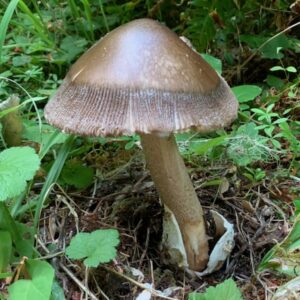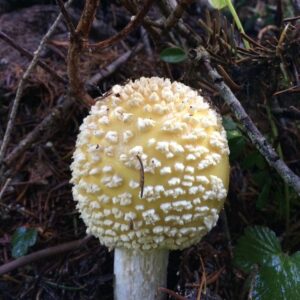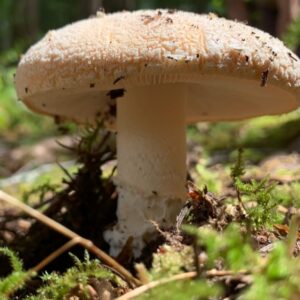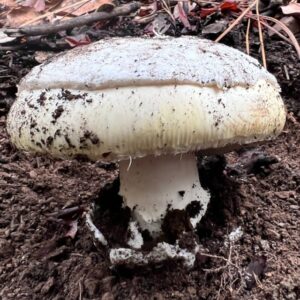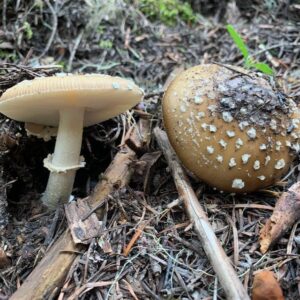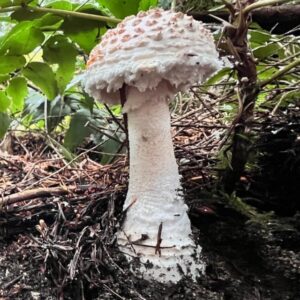[et_pb_section fb_built=”1″ admin_label=”section” _builder_version=”4.16″ global_colors_info=”{}” theme_builder_area=”post_content”][et_pb_row admin_label=”row” _builder_version=”4.16″ background_size=”initial” background_position=”top_left” background_repeat=”repeat” global_colors_info=”{}” theme_builder_area=”post_content”][et_pb_column type=”4_4″ _builder_version=”4.16″ custom_padding=”|||” global_colors_info=”{}” custom_padding__hover=”|||” theme_builder_area=”post_content”][et_pb_text _builder_version=”4.23.1″ _module_preset=”default” global_colors_info=”{}” theme_builder_area=”post_content”]
The Amanita genus includes some of the most seriously poisonous mushrooms as well as some edible species. Learning to recognize Amanita mushrooms is important if you intend to forage for other robust gilled mushrooms like matsutake and even puffballs.
[/et_pb_text][et_pb_image src=”https://salishmushrooms.com/wp-content/uploads/2023/03/embroidered-amanita-AI-digital-illustration-300×300.png” title_text=”embroidered amanita AI digital illustration” _builder_version=”4.20.2″ _module_preset=”default” global_colors_info=”{}” theme_builder_area=”post_content”][/et_pb_image][/et_pb_column][/et_pb_row][et_pb_row _builder_version=”4.16″ _module_preset=”default” global_colors_info=”{}” theme_builder_area=”post_content”][et_pb_column type=”4_4″ _builder_version=”4.16″ _module_preset=”default” global_colors_info=”{}” theme_builder_area=”post_content”][et_pb_text admin_label=”Disclaimer” _builder_version=”4.23.1″ _module_preset=”default” text_font_size=”14px” text_line_height=”1.2em” text_font_size_tablet=”11px” text_font_size_phone=”8px” text_font_size_last_edited=”on|desktop” global_colors_info=”{}” theme_builder_area=”post_content”]
Please Note: genetic sequencing is teaching us that we have misapplied names to many of our local mushrooms. The categorization below does not reflect the most recent updates to the names of some of these mushrooms. Please message me with suggestions for improving the accuracy for anything on this site.
[/et_pb_text][et_pb_text admin_label=”Features” _builder_version=”4.23.1″ _module_preset=”default” global_colors_info=”{}” theme_builder_area=”post_content”]
Features of Amanita
You can see that Amanita species often have a very similar set of features. Amanita group from an egg-like structure that leaves remnants on the cap and base of the mushroom. The tissue that encompasses the entire mushroom at this early stage is known as a universal veil. Remnants of the universal veil can include removable, non-removable warts that appear ironed on, or a toupee / eggy patch / skullcap of unbroken tissue on the cap.
The Gills of Amanita are always light-colored and a spore print will be pale. Many Amanitas have a skirt-like ring around the stem. This ring is tissue left from a partial veil that had covered the underside of the gills before the cap fully opened. The tissue of this ring can vary in durability so you might find it to be leathery and in other instances, it can disintegrate more quickly.
The Base of Amanitas often have remnants of the universal veil including a bulbous or sac-like base that may have circular rings, or just splits open like a mussel shell. The shape of this unique base can be an important characteristic for identification. The stem might flare smoothly to the bulbous base, or it can have an abrupt shelf. Circular rings of tissue stacked along the base of the stem can also be helpful for identification.
Toxicity There is a more thorough summary of the edibility of Amanita muscaria at the bottom of this page. This genus is critical to know by anyone foraging mushrooms because it contains some of the most seriously toxic mushrooms.
It is ok to touch poisonous mushrooms
Grisettes and Amanita coccora / A. vernicoccora are edible however this page in not yet adequate for identifying edible Amanitas.
[/et_pb_text][/et_pb_column][/et_pb_row][et_pb_row column_structure=”1_3,1_3,1_3″ _builder_version=”4.16″ _module_preset=”default” global_colors_info=”{}” theme_builder_area=”post_content”][et_pb_column type=”1_3″ _builder_version=”4.16″ _module_preset=”default” global_colors_info=”{}” theme_builder_area=”post_content”][et_pb_text admin_label=”augusta” _builder_version=”4.16″ _module_preset=”default” global_colors_info=”{}” theme_builder_area=”post_content”]
Amanita augusta
[/et_pb_text][et_pb_text admin_label=”pachycolea” _builder_version=”4.16″ _module_preset=”default” global_colors_info=”{}” theme_builder_area=”post_content”]
Amanita pachycolea
[/et_pb_text][/et_pb_column][et_pb_column type=”1_3″ _builder_version=”4.16″ _module_preset=”default” global_colors_info=”{}” theme_builder_area=”post_content”][et_pb_text admin_label=”gemmata” _builder_version=”4.17.6″ _module_preset=”default” global_colors_info=”{}” theme_builder_area=”post_content”]
Amanita gemmata grp
[/et_pb_text][et_pb_text admin_label=”Aprica” _builder_version=”4.16″ _module_preset=”default” global_colors_info=”{}” theme_builder_area=”post_content”]
Amanita aprica
[/et_pb_text][et_pb_text admin_label=”vernicoccora” _builder_version=”4.16″ _module_preset=”default” global_colors_info=”{}” theme_builder_area=”post_content”]
Amanita vernicoccora
[/et_pb_text][/et_pb_column][et_pb_column type=”1_3″ _builder_version=”4.16″ _module_preset=”default” global_colors_info=”{}” theme_builder_area=”post_content”][et_pb_text admin_label=”pantherina” _builder_version=”4.17.6″ _module_preset=”default” global_colors_info=”{}” theme_builder_area=”post_content”]
Amanita pantherina grp
[/et_pb_text][et_pb_text admin_label=”smithiana” _builder_version=”4.16″ _module_preset=”default” global_colors_info=”{}” theme_builder_area=”post_content”]
Amanita smithiana
[/et_pb_text][/et_pb_column][/et_pb_row][et_pb_row _builder_version=”4.16″ _module_preset=”default” global_colors_info=”{}” theme_builder_area=”post_content”][et_pb_column type=”4_4″ _builder_version=”4.16″ _module_preset=”default” global_colors_info=”{}” theme_builder_area=”post_content”][et_pb_text _builder_version=”4.23.1″ _module_preset=”default” global_colors_info=”{}” theme_builder_area=”post_content”]
Edibility of Amanita muscaria
In short, Amanita muscaria can be edible once the neurotoxins have been removed. The most common method for removing these toxins is to boil the mushrooms in a large volume of water for 20min, dump that water, repeat twice, then rinse the mushrooms before cooking. This works because the toxins are water-soluble and so boiling in water significantly dilutes what is in the mushroom.
If you are considering eating Amanita muscaria or are simply interested in learning more I recommend reading this article from Debbie Viess. Her article is partly a direct response to an article by William Rubel and David Arora.
A crude digest of these two articles is:
- Many mushrooms labeled as inedible in guidebooks are actually edible
- This can be observed easily through a survey of mushroom-eating behavior around the world
- Our cultural biases create and then perpetuate misunderstanding of the edibility of certain mushroom species
- Amanita muscaria is one such example of a mushroom that could be safely eaten that we treat as inedible
Debbie’s response (again a crude summary)
- Yes, Amanita muscaria can be edible when prepared properly however
- “edible” might be a misapplication to a mushroom that requires such significant preparation to render it edible
- The authors may be overstating the culinary use in of this mushroom in certain cultures
- When Amanitas are eaten often times it is just a small amount after further processing (pickling)
[/et_pb_text][et_pb_text _builder_version=”4.16″ _module_preset=”default” global_colors_info=”{}” theme_builder_area=”post_content”]
Further Reading
Danny Miller’s Amanitaceae page
Amanitaceae.org
MushroomExpert.com
[/et_pb_text][et_pb_button button_text=”Click Here” _builder_version=”4.20.2″ _module_preset=”default” global_colors_info=”{}” theme_builder_area=”post_content”][/et_pb_button][/et_pb_column][/et_pb_row][/et_pb_section]


